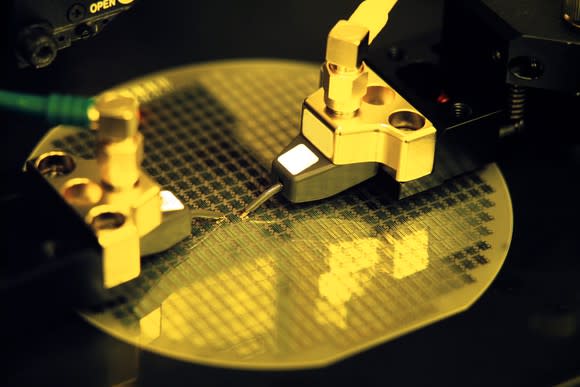3 Things You Didn't Know About Micron Technology, Inc.
You know that Micron Technology (NASDAQ: MU) is a leading designer and manufacturer of computer memory chips. You might be familiar with the differences between Micron's two major product categories -- namely, NAND chips allowing long-term storage and DRAM chips used to handle operating memory needs where the memory cells go blank every time you turn the machine off. Maybe you've even heard that the company isn't anywhere near Silicon Valley, operating out of idyllic Boise, Idaho, for the entire four decades of Micron's history.
Even if you knew all of that, I'm sure you don't know absolutely everything about Micron and its complex business. Let me fill you in on a handful of open secrets that will help you evaluate Micron as an investment opportunity.
Spoiler alert: Micron looks like a solid buy right now.

Image source: Getty Images.
Micron's market is bigger than you think
There was a time where Micron's fortunes depended almost exclusively on demand for PCs. Going back to 2006, the company had just started to explore the NAND market but management saw it as a "negligible" source of end-user demand for the foreseeable future. The smartphone explosion was still in the future and it would have been crazy expensive to build large-scale storage devices out of that era's NAND chips. The biggest consumer of Micron's fledgling NAND production was the portable audio player market.
Today, smartphones and solid-state storage devices (SSD) create massive demand for Micron's NAND chips. Micron's management expects SSD-based sales to grow at an annual rate of more than 40% for the next five years. DRAM growth should continue at a lower but healthy 20% annual pace, driven by a shifting market mix. Smartphones keep shipping with larger and larger DRAM capacities, automotive computing is taking off in a big way, and the Internet of Things provides another major growth opportunity for both NAND and DRAM chips.
So if you thought that Micron's future was restricted by what's going on in the PC market, you need to adjust that view in several ways. PC-related sales are growing thanks to SSD technology replacing old-school magnetic disks, and Micron is exploring fresh growth in many non-PC markets as well.

Image source: Micron Technology.
Micron's cyclical swings are amplified by large fixed costs
The company runs its own manufacturing operations rather than outsourcing the work to semiconductor foundries. That leads to big losses when market demand runs low, but also generates higher profits in good times.
We already looked at many markets generating high demand for Micron's products. At the same time, the company is tightening up its operating costs and focusing on higher-margin chip production. These efforts have resulted in a $6 billion increase in annual operating profits since 2016, and management expects to bring in another $3 billion of yearly cost-cutting and margin-boosting effects in the next five years.
Assuming that the demand picture holds steady over that time frame, that's great news for Micron investors. Next up, let me explain why I think that Micron's markets should be able to avoid the roller-coaster downturns they have experienced on a regular basis in the past.
Micron only has two serious rivals
That would be South Korean memory giants Samsung (NASDAQOTH: SSNLF) and SK Hynix. Samsung controls nearly half the global market for DRAM chips while Hynix and Micron split the other half down the middle. Other chip manufacturers play a forgettable role in the total market. The NAND sector is a bit more diversified thanks to the presence of Western Digital (NASDAQ: WDC) and its all-important SanDisk subsidiary but Micron is one of the largest suppliers in this segment as well.
A couple of state-backed memory manufacturers are making waves in China these days and Micron is keeping an eye on any potential challenges from that sector. The Chinese upstarts are brand new to a market that Micron has been leading for decades on end, and most of them haven't even shipped any chips yet. When they do, their output might end up exclusively in devices intended for the Chinese market. For now, Chinese names like Hefei Innotron and Fujian Jinhua don't pose any real threat to Micron's business growth.
Having just a handful of leading chip suppliers for a worldwide market as vibrant as the memory industry lets Micron and its peers control the supply-and-demand equation to an unprecedented degree. That's why chip prices have stabilized in recent quarters, as the leading memory makers keep a tight leash on their production lines in order to encourage higher unit prices.
This is the new normal in an industry that has grown used to brutal price wars. Micron's shares are trading at seven times trailing earnings today as if another market panic were inevitable and imminent. That's not how it works anymore, so Micron's valuation ratios should expand as the new market reality continues to play out.
And that makes Micron a fantastic buy at these deeply discounted prices.
More From The Motley Fool
Anders Bylund owns shares of Micron Technology. The Motley Fool has no position in any of the stocks mentioned. The Motley Fool does have a disclosure policy, though.
